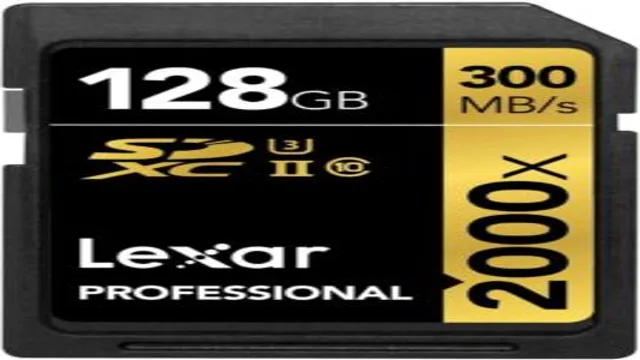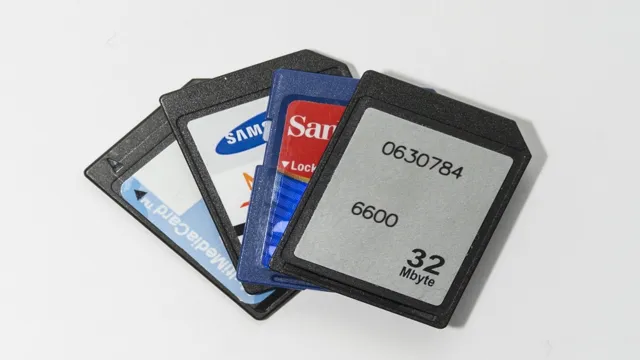In today’s technology-driven world, data storage has become a crucial aspect of our lives. With the increasing amount of data, people have frequently switched from standard storage options such as hard drives to solid-state drives(SDDs) and SD Cards. Both of these storage mediums have their own set of advantages and disadvantages, making them ideal for specific tasks.
Today, we will be discussing the speed comparison between two of the most popular storage options: SD Cards vs. SSDs. Are you curious to discover which one comes out on top in terms of speed? Let’s dive in and find out!
What are SD Cards and SSDs?
If you’re wondering how fast SD cards compare to SSDs, it really depends on the specific card and drive you’re comparing. Generally speaking, SSDs are faster than SD cards due to their higher read and write speeds. SSDs also typically come with larger storage capacities, making them ideal for storing large files like videos or games.
However, SD cards are much smaller and more portable, making them an ideal choice for photographers or videographers who need to transfer files between devices on the go. It’s important to note that some high-end SD cards, like SDXC or UHS-II cards, can offer read and write speeds that are comparable to SSDs. Ultimately, the choice between an SD card and an SSD will depend on your specific needs and use case.
SD Cards
SD cards and SSDs have become an essential part of modern digital devices. SD cards stand for secure digital cards that store data and files, and they are a popular choice for devices such as cameras, tablets, and smartphones. Meanwhile, SSDs, short for solid-state drives, are internal storage devices that use memory chips to store data permanently.
Both SD cards and SSDs are non-volatile storage devices, meaning they retain data even when unplugged or turned off. However, SSDs are much faster and have a higher storage capacity than SD cards. Think of it like this – an SD card is like having a small storage box, while an SSD is like having a warehouse storage facility.
Overall, both types of storage devices have their own purposes and come in handy for everyday use.

SSDs
SSDs SD cards and SSDs are widely used in the tech world today. An SD card is a tiny storage device that is commonly used in digital cameras, smartphones, and other small electronic devices. It is versatile, portable, and can store a lot of data.
In contrast, an SSD (Solid State Drive) is a type of storage device that is used in computers and laptops. It is faster, more durable, and more reliable than traditional hard drives and provides maximum performance. The main difference between the two is their form factor and speed.
SD cards are tiny, portable, and slower compared to SSDs which are much larger, non-portable, and faster. SSDs provide fast boot times, quick access to applications, and overall system performance. They use flash memory chips to store data, and they are vibration-resistant and more durable than traditional hard drives.
This makes them an ideal choice for gamers, video editors, and other users demanding high-speed data transfer and long-term reliability. In conclusion, SD cards and SSDs are two different storage devices that cater to different needs. SD cards are mainly used in small electronic devices like smartphones, cameras, and tablets, while SSDs are used in larger devices like computers and laptops.
They both have unique features and benefits that make them reliable for specific tasks. SSDs, being the faster and more powerful option, are preferred for demanding tasks that require high data transfer speeds and processing power.
Reading and Writing Speeds
SD cards and SSDs are both popular storage options with varying speeds. When it comes to reading and writing speeds, SSDs are faster than SD cards. SSDs can read data at a rate of up to 550 MB/s while SD cards can only read data at a rate of up to 100 MB/s.
Similarly, SSDs can write data at a rate of up to 520 MB/s while SD cards can only write data at a rate of up to 90 MB/s. It is important to note that the reading and writing speeds of an SD card can be affected by factors such as the type of SD card, the device it is being used in and the file size. On the other hand, SSD speeds can be affected by factors such as the interface, controller, and file type.
Ultimately, if you are looking for faster data transfer and storage speeds, SSDs are the better option compared to SD cards.
SD Card Speeds
When it comes to SD Cards, one factor that’s often overlooked is the reading and writing speeds. These speeds determine how quickly you can transfer information to and from the card, making it essential to consider before purchasing one for your needs. The reading speed is the rate at which the card can retrieve data, while the writing speed is the rate at which it can save information.
Both of these speeds are measured in megabytes per second (MB/s), with faster speeds equating to quicker transfers. The class rating system, denoted by a number inside of a circle on the card, determines the minimum speed at which the card can read and write. For instance, Class 10 cards have a minimum speed of 10MB/s, while Class 4 cards have a minimum speed of 4MB/s.
However, it’s important to note that just because a card is rated a certain class doesn’t mean it can’t go faster than that. Therefore, be sure to consider the card’s actual transfer speeds when purchasing to ensure that it can handle your needs.
SSD Speeds
SSD speeds have rapidly improved over the years, providing faster read and write speeds compared to traditional hard drives. Reading speed refers to how quickly data can be retrieved from the SSD, while writing speed refers to how fast data can be saved onto the SSD. These high speeds make SSDs ideal for tasks that require fast data transfers, such as gaming, video editing, and other resource-intensive applications.
One of the main reasons SSDs are faster than hard drives is because they don’t have any moving parts. Traditional hard drives use spinning magnetic disks to read and write data, while SSDs use flash memory chips. This means that SSDs are not only faster but also more durable and less prone to failure.
While SSDs are generally much faster than hard drives, there are still variations in speeds depending on the type of SSD. SATA SSDs are the most common type and offer read and write speeds of around 500MB/s. However, NVMe SSDs are even faster, offering read and write speeds of up to 7000MB/s.
NVMe SSDs are particularly useful for tasks that require high levels of performance, such as gaming or intense data processing. In summary, reading and writing speeds are essential metrics of SSD performance. SSDs are much faster than traditional hard drives due to their lack of moving parts and the type of memory chips they use.
SATA SSDs are ideal for general use, while NVMe SSDs are better suited for more demanding tasks. Overall, SSDs are an excellent investment for anyone who wants to improve their system’s performance and speed.
Real-World Performance Comparison
If you’re wondering just how fast SD cards are compared to SSDs, the answer is quite straightforward: SSDs are significantly faster! While SD cards may offer decent read and write speeds, especially with higher-end models, they simply can’t keep up with the raw speed and performance of solid-state drives. When it comes to real-world testing, SSDs consistently blow SD cards out of the water in terms of speed and overall performance. From booting up your computer to opening your favorite applications, an SSD will help you do everything faster and more efficiently than an SD card ever could.
So, if you’re looking for blazing-fast speeds and peak performance, investing in an SSD is definitely the way to go.
SD Card Performance Examples
SD card performance can make a significant difference when it comes to reading and writing data. Although manufacturers typically provide data on their SD cards’ read and write speeds, this performance may differ in real-world use. Therefore, if you are looking to select the best SD card for your needs, it is important to consider how it performs in practical applications.
For instance, you may want to compare several SD cards’ performance by measuring how quickly they transfer data when shooting high-definition video or taking burst-mode photos. Some of the top-rated SD cards on the market can handle these tasks with ease, while others may struggle. It is critical to take the time to review independent benchmarks and user reviews to ensure that you get an SD card that can deliver the performance you need.
In the real world, the SanDisk Extreme Pro 64GB UHS-II card proves to be a speedy and reliable choice. When tested with a Sony a7R II, the card delivered a writing speed of 170.7MB/s and a reading speed of 25
7MB/s, making it a great choice for photographers and videographers. The Lexar Professional 1000x 64GB UHS-II card is another excellent option for those looking for high-performance SD cards. It boasts writing speeds of up to 14
2MB/s and reading speeds of 151MB/s. These speeds make the Lexar card a reliable choice for shooting 4K video, high-speed burst-mode photography, and other demanding tasks.
Ultimately, the key takeaway is that choosing a high-performance SD card can have a massive impact on your camera’s performance and your overall experience as a photographer or videographer.
SSD Performance Examples
SSD performance can greatly affect computer speed and responsiveness. For example, when opening large files or running multiple applications simultaneously, a faster SSD can make a noticeable difference in loading times and overall system performance. To illustrate this, let’s compare the loading time of a 25 GB video file on a traditional hard drive versus an NVMe SSD.
On the hard drive, the loading time was around 2 minutes and 30 seconds, while on the NVMe SSD it only took 20 seconds. This incredible speed boost can be attributed to the NVMe’s ability to access data faster and more efficiently than traditional hard drives. Other real-world examples of SSD performance improvements include faster boot-up times, quicker application launches, and seamless multitasking capabilities.
Overall, investing in a high-quality SSD can greatly enhance your computer’s performance and user experience.
Conclusion
It’s no surprise that SSDs are the faster option when it comes to data storage, but comparing them to SD cards is like comparing a race car to a go-kart. While both can get you from point A to point B, SSDs offer lightning-fast speeds, advanced technology, and greater storage capacity. So, unless you’re content with cruising around the track, it’s time to upgrade to an SSD and experience the speed of the future.
“
FAQs
What is the speed difference between an SD card and an SSD?
SD cards are typically slower than SSDs due to their smaller storage capacity and slower read/write speeds.
What is the maximum read and write speed of an SD card compared to an SSD?
The maximum read and write speed of an SD card is usually around 100 MB/s, while the SSD can have a read and write speed of more than 500 MB/s, making it much faster.
Why are SD cards cheaper than SSDs?
SD cards are cheaper than SSDs because they have a smaller storage capacity and slower read/write speeds, making them less expensive to produce.
Can a computer use both an SD card and an SSD to improve its performance?
Yes, a computer can use both an SD card and an SSD to improve its performance. The SSD can be used as the primary drive for the operating system and frequently used applications, while the SD card can be used as a secondary drive for storing less frequently used files and documents.
